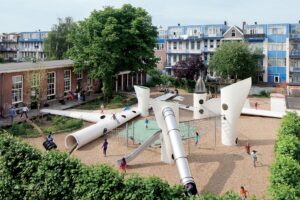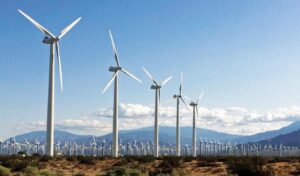By Carol Fisher-Linn
Think floor tiles, road barriers and playground equipment….
Windmills are so cool to look at, aren’t they? When you drive through the countryside you can’t help to be captivated by the enormousness of these behemoths of industry. Whether you love them or hate them, they are a sight to behold. The widely used GE 1.5-megawatt model, for example, consists of 116-ft blades (about twenty times as tall as +7-foot Shaq O’Neal or half the size of a football field) atop a 212-ft tower for a total height of 328 feet (the length of a football field with one extra endzone – or the Statue of Liberty from the ground up including the base at 305 feet). The blades sweep a vertical airspace of just under an acre. The propeller rotates at 15 revolutions per minute. These mechanical wonders are monstrous!

I use the word monstrous deliberately because, alas, for all the green energy they harness and produce, they have, up until the last few years, left a not-so-green legacy. Most of the outdated and used-up blades go into the landfills or are incinerated, neither of which is a plus for our environment. What happened to all the talk about recycling them? By now, we Americans are savvy about the claims industrial giants make just to get their foot in the door. Even though we have doubts we still hold on to the hope that maybe they might come through with their recycling claims.

Here’s what Miriam Webster has to say about recycling: to pass again through a series of changes or treatments – presently there are no chemical processes to separate the individual composite materials from one another in an economical way. To process (something, such as glass, or cans) in order to regain material for human use, all the metal components of windmills can easily be processed, but they only recycle a small fraction that the blades themselves could. To bring back: REUSE – chances don’t appear very good for the original blades made twenty-some years ago, which were not designed for recyclability. They are now being retired and mostly land filled. To adapt to a new use: ALTER – One company overseas uses their old blades as wall partitions. And, there has been some success recycling the filaments creating a 3D printing feedstock from recycled windmill blades.
Windpowerengineering.com has a 2/25/16 article “Reaching Retirement: Recycling Aging Turbine Blades”, by Michelle Froese. Froese writes about a research project in Denmark called “Dreamwind” where scientists at Aarhus University were working to develop a chemical substance that would do something that could not be done up until now – separate the composite materials from each other, which was the main problem in recycling them. (dreamwind.dk) If the completed project reached its goals (separating the glass fibers from the plastic fibers), it could bring about a sea change in what happens to these used blades. The researchers focused on developing an agent for fiberglass. The idea is that the glass is worth reusing once separated and cleaned for new fiberglass components for structures such as wind turbines, aircraft, or cars.
In the U.S., Washington State University is working with Seattle-based Global Fiberglass Systems (GFS) to recycle old turbine blades. The first step is breaking the blades up. Since thermal and chemical treatments are cost prohibitive, WSU simply cut the turbine blades into palm-sized pieces, refined them, and processed them into new composite material – which held up equally as well as do many wood composites. So, think floor tiles and plastic road barriers.
Here’s something interesting: go to the internet and type in Spares in Motion, then wind turbine blades. It seems old blades are reconditioned for second-hand use. Who knew?
Here’s the greatest part, at least to the kid in me. Life & Soul Magazine (lifeandsoulmagazine.com) has an 11/12/17 article (Wikado) Playground: Kids playground built from discarded wind turbine parts) on using old turbine blades for FUN! Discarded wind turbine blades have found a second life as a futuristic-style kids’ playground in the Netherlands. The Rotterdam-based playground is a maze-like structure made from five discarded wind turbine blades that have been cut up into parts and re-painted. The recycled blades make up a slide tower, a watch tower, tunnels, bridges, ramps, and slides. Wouldn’t a playground like that be incredible in our fun-loving village?
